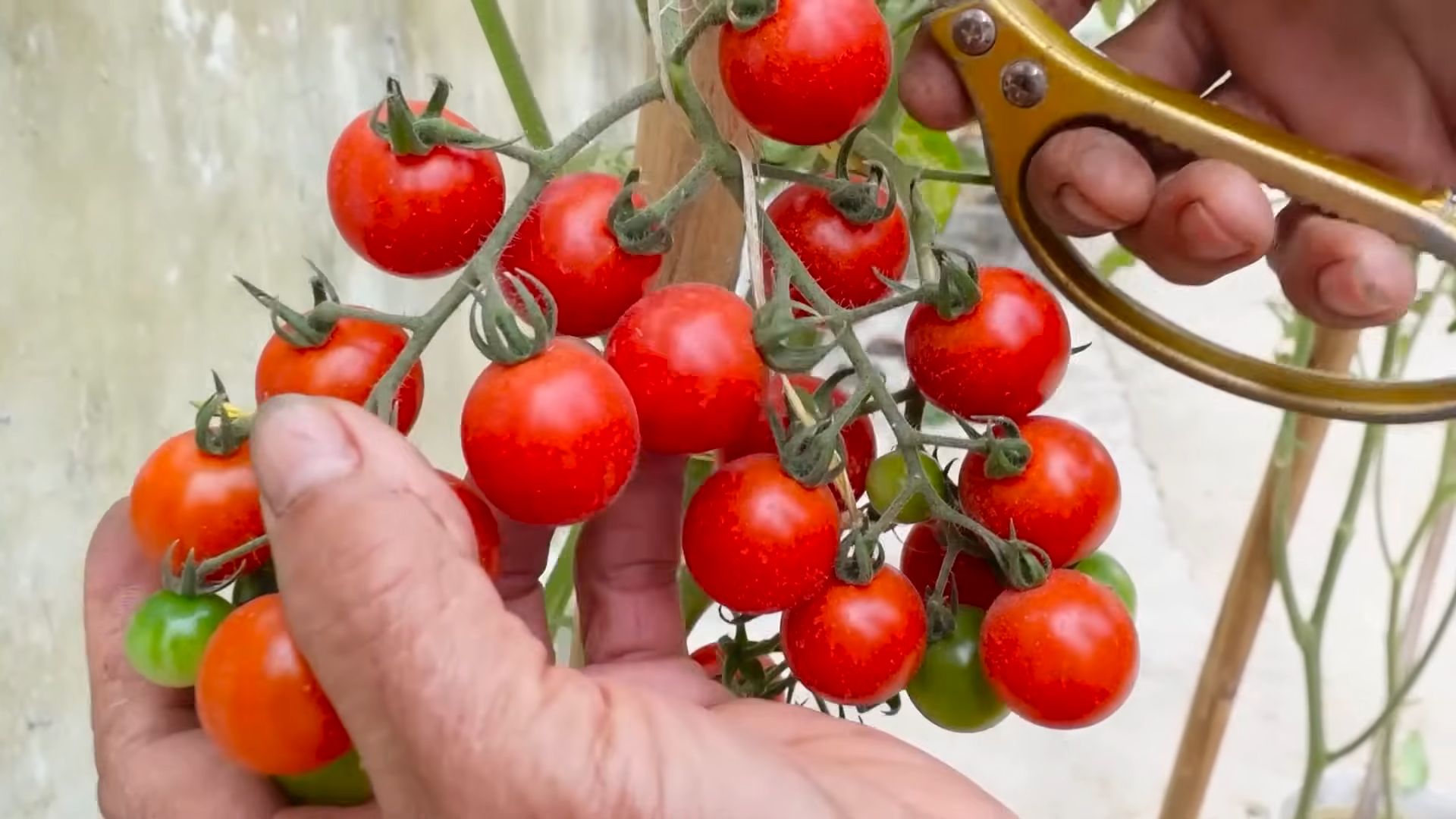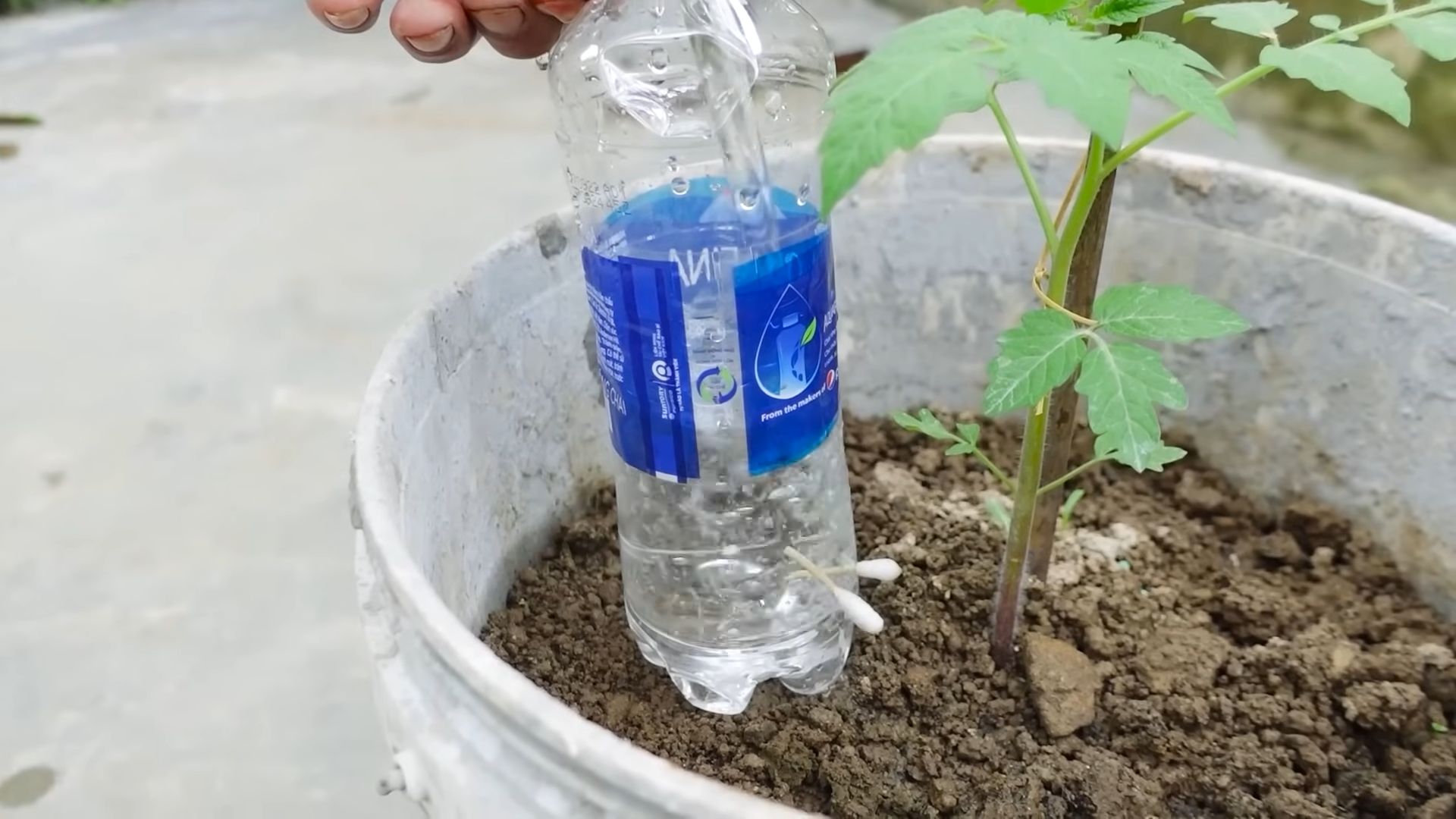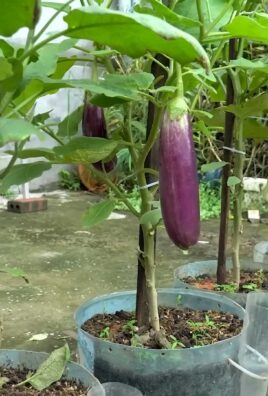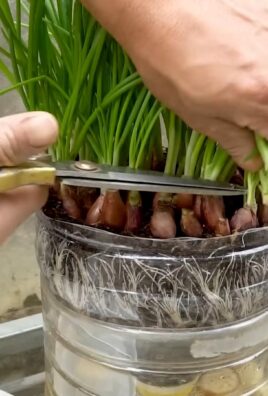Grow Grape Tomatoes Easily, even if you think you have a black thumb! Have you ever dreamt of plucking juicy, sun-ripened grape tomatoes straight from your own garden, popping them into your mouth for a burst of sweet, tangy flavor? I know I have! For centuries, cultivating tomatoes, in all their glorious forms, has been a cherished tradition, connecting us to the earth and providing us with delicious, nutritious food. From their origins in South America to their adoption by cultures worldwide, tomatoes have become a staple in our diets and a symbol of home-grown goodness.
But let’s be honest, sometimes gardening feels more like a chore than a joy, especially when those delicate grape tomatoes refuse to thrive. That’s where these simple, yet effective, DIY tricks come in! I’m going to share some of my favorite hacks that will help you grow grape tomatoes easily, even if you’re short on space, time, or experience. Imagine the satisfaction of harvesting baskets overflowing with these little gems, knowing you nurtured them from tiny seedlings to vibrant, flavorful fruits.
These tips are essential because everyone deserves to experience the joy of fresh, homegrown produce. Plus, store-bought grape tomatoes simply can’t compare to the taste of those grown with your own love and care. So, ditch the store-bought blandness and get ready to transform your garden (or even your balcony!) into a grape tomato paradise. Let’s get started!

Grow Grape Tomatoes Easily: A DIY Guide for Bountiful Harvests
Hey there, fellow gardening enthusiasts! I’m super excited to share my foolproof method for growing grape tomatoes. Trust me, even if you think you have a black thumb, you can totally rock this. I’ve refined this process over several seasons, and now I’m practically swimming in delicious, sweet grape tomatoes. Let’s get started!
Choosing the Right Grape Tomato Variety
Before we dive into the nitty-gritty, let’s talk about tomato varieties. While this guide works for most grape tomato types, some are definitely easier to grow and more productive than others.
* ‘Sungold’: These are my absolute favorite! They’re incredibly sweet and have a beautiful golden color. They tend to be a bit more prone to cracking, but the flavor is worth it.
* ‘Sweet Million’: A classic choice, known for its high yields and disease resistance. The tomatoes are a bit smaller than ‘Sungold’ but still packed with flavor.
* ‘Juliet’: Another reliable variety with good disease resistance and a slightly elongated shape. They’re great for snacking and salads.
* ‘Santa’: A popular choice for its rich flavor and resistance to cracking.
I recommend starting with ‘Sweet Million’ or ‘Juliet’ if you’re a beginner. They’re super forgiving and will give you a great sense of accomplishment.
Getting Started: Seeds vs. Seedlings
You have two main options for starting your grape tomato plants: from seeds or from seedlings (also called transplants).
* Starting from Seeds: This is the more economical option, and it gives you more control over the entire process. However, it requires a bit more time and effort. You’ll need to start your seeds indoors about 6-8 weeks before the last expected frost.
* Buying Seedlings: This is the easier and faster option. You can find seedlings at most garden centers in the spring. Just make sure to choose healthy-looking plants with sturdy stems and no signs of disease.
I personally prefer starting from seeds because I love watching them sprout and grow. But if you’re short on time or space, seedlings are a perfectly fine option.
Section 1: Starting from Seeds (If You Choose This Route)
Okay, so you’re ready to start your grape tomatoes from seeds? Awesome! Here’s what you’ll need:
* Seed starting trays or small pots
* Seed starting mix (a light, sterile soil mix)
* A spray bottle
* A heat mat (optional, but helpful)
* A grow light (optional, but recommended)
Step-by-Step Instructions for Starting Seeds:
1. Prepare Your Seed Starting Trays: Fill your seed starting trays or pots with seed starting mix. Gently tap the trays to settle the soil.
2. Sow the Seeds: Make a small indentation (about 1/4 inch deep) in the center of each cell or pot. Place 2-3 seeds in each indentation. This increases the chances of at least one seed germinating.
3. Cover the Seeds: Gently cover the seeds with seed starting mix.
4. Water the Seeds: Use a spray bottle to lightly mist the soil. You want to keep the soil moist but not soggy.
5. Provide Warmth and Light: Place the seed starting trays on a heat mat (if using) and under a grow light (if using). The ideal temperature for germination is around 70-75°F. If you don’t have a heat mat or grow light, you can place the trays in a warm, sunny location.
6. Keep the Soil Moist: Check the soil daily and mist it with water as needed to keep it moist.
7. Thin the Seedlings: Once the seedlings have emerged and have their first true leaves (the second set of leaves), thin them to one seedling per cell or pot. Choose the strongest, healthiest-looking seedling and snip off the others at the soil line. Don’t pull them out, as this can disturb the roots of the remaining seedling.
8. Harden Off the Seedlings: About a week before you plan to transplant the seedlings outdoors, you’ll need to “harden them off.” This means gradually exposing them to outdoor conditions to help them adjust. Start by placing the trays outdoors in a sheltered location for a few hours each day, gradually increasing the amount of time they spend outside.
Section 2: Preparing Your Garden Bed or Containers
Whether you’re starting from seeds or seedlings, you’ll need to prepare your garden bed or containers before transplanting your grape tomato plants.
* Choosing a Location: Grape tomatoes need at least 6-8 hours of sunlight per day. Choose a location that gets plenty of sun.
* Soil Preparation: Grape tomatoes prefer well-drained soil that is rich in organic matter. If you’re planting in a garden bed, amend the soil with compost or well-rotted manure. If you’re planting in containers, use a high-quality potting mix.
* Container Size: If you’re growing grape tomatoes in containers, choose pots that are at least 12 inches in diameter and 12 inches deep. Larger pots are even better, as they will provide more room for the roots to grow.
Step-by-Step Instructions for Preparing Your Garden Bed or Containers:
1. Clear the Area: Remove any weeds, rocks, or debris from the area where you plan to plant your grape tomatoes.
2. Amend the Soil: If you’re planting in a garden bed, dig in compost or well-rotted manure to improve the soil’s fertility and drainage.
3. Fill the Containers: If you’re planting in containers, fill them with high-quality potting mix.
4. Water the Soil: Water the soil thoroughly before planting.
Section 3: Transplanting Your Grape Tomato Plants
Now comes the fun part: transplanting your grape tomato plants into their permanent home!
* Timing: Wait until the danger of frost has passed before transplanting your grape tomato plants outdoors. The soil temperature should be at least 60°F.
* Spacing: Space your grape tomato plants about 2-3 feet apart in the garden bed. If you’re growing them in containers, plant one plant per container.
* Planting Depth: Plant your grape tomato plants slightly deeper than they were growing in their original containers. This will encourage them to develop more roots along the buried stem.
Step-by-Step Instructions for Transplanting:
1. Dig a Hole: Dig a hole that is slightly larger than the root ball of your grape tomato plant.
2. Remove the Plant from the Container: Gently remove the plant from its container. If the roots are pot-bound (tightly circling the bottom of the pot), gently loosen them with your fingers.
3. Place the Plant in the Hole: Place the plant in the hole and make sure the top of the root ball is level with the surrounding soil.
4. Fill the Hole: Fill the hole with soil and gently firm it around the plant.
5. Water the Plant: Water the plant thoroughly.
6. Add Support: Grape tomato plants can get quite tall and heavy, so it’s important to provide them with support. You can use stakes, cages, or trellises. I personally prefer using tomato cages because they’re easy to install and provide good support. Insert the support structure immediately after planting to avoid damaging the roots later.
Section 4: Caring for Your Grape Tomato Plants
Once your grape tomato plants are in the ground, it’s important to provide them with proper care to ensure a bountiful harvest.
* Watering: Water your grape tomato plants regularly, especially during hot, dry weather. Aim to water deeply and less frequently, rather than shallowly and more often. This encourages the roots to grow deeper, making the plants more drought-tolerant.
* Fertilizing: Fertilize your grape tomato plants every 2-3 weeks with a balanced fertilizer. Look for a fertilizer that is specifically formulated for tomatoes. I like to use a liquid fertilizer because it’s easy to apply and the plants can absorb it quickly.
* Pruning: Pruning your grape tomato plants can help improve air circulation and prevent disease. Remove any suckers (the small shoots that grow between the main stem and the branches) that appear below the first flower cluster.
* Mulching: Mulching around your grape tomato plants can help retain moisture in the soil, suppress weeds, and regulate soil temperature. Use organic mulch such as straw, hay, or wood chips.
* Pest and Disease Control: Keep an eye out for pests and diseases. Common pests that affect grape tomatoes include aphids, tomato hornworms, and whiteflies. Common diseases include early blight, late blight, and blossom end rot. If you notice any signs of pests or diseases, take action immediately. There are

Conclusion
So, there you have it! Growing grape tomatoes easily doesn’t have to be a daunting task reserved for seasoned gardeners. With this simple DIY trick, you can transform your patio, balcony, or even a sunny windowsill into a thriving miniature tomato farm. The beauty of this method lies in its accessibility and cost-effectiveness. Forget expensive gardening equipment or complicated setups. All you need are a few readily available materials and a little bit of patience to unlock a bountiful harvest of sweet, juicy grape tomatoes.
This method isn’t just about saving money; it’s about connecting with your food, understanding the growing process, and experiencing the immense satisfaction of nurturing something from seed to table. Imagine the pride you’ll feel when you pluck those first ripe tomatoes, bursting with flavor, and share them with family and friends. They’ll be amazed by your green thumb, and you’ll know it all started with this easy DIY technique.
But don’t just take our word for it. The real magic happens when you try it yourself. We encourage you to experiment with different varieties of grape tomatoes. Perhaps you’d like to try a yellow grape tomato for a sweeter taste, or a red variety for a classic flavor. You can also adjust the size of your container to accommodate more plants, or even try companion planting with herbs like basil or oregano to enhance the flavor of your tomatoes and deter pests naturally. Consider adding a small trellis or support structure as your plants grow taller and heavier with fruit. This will help prevent the stems from breaking and ensure a more abundant harvest.
This DIY trick is a must-try because it empowers you to take control of your food source, reduces your reliance on store-bought produce, and provides a rewarding and educational experience. It’s a sustainable and eco-friendly way to enjoy fresh, delicious grape tomatoes all season long. Plus, it’s a fantastic project to involve children in, teaching them about the wonders of nature and the importance of healthy eating.
Don’t be afraid to get your hands dirty and embrace the joy of gardening. We’re confident that you’ll be amazed by the results. So, gather your supplies, follow the steps outlined, and prepare to be amazed by the abundance of grape tomatoes you’ll be harvesting in no time.
We’re eager to hear about your experiences! Share your photos, tips, and stories in the comments below. Let’s create a community of DIY tomato growers and inspire others to discover the joys of homegrown produce. What worked well for you? What challenges did you face? What variations did you try? Your feedback will help us refine this method and make it even easier for others to succeed. So, go ahead, give it a try, and let us know how it goes! Happy gardening!
Frequently Asked Questions (FAQ)
What kind of soil should I use for growing grape tomatoes?
The best soil for growing grape tomatoes is a well-draining potting mix that is rich in organic matter. Avoid using garden soil directly in containers, as it can become compacted and hinder drainage. Look for a potting mix specifically formulated for vegetables or tomatoes. You can also amend your potting mix with compost or other organic materials to improve its fertility and drainage. A slightly acidic soil pH of around 6.0 to 6.8 is ideal for grape tomatoes.
How often should I water my grape tomato plants?
Water your grape tomato plants regularly, especially during hot and dry weather. The frequency of watering will depend on the size of your container, the type of soil you’re using, and the weather conditions. As a general rule, water deeply whenever the top inch of soil feels dry to the touch. Avoid overwatering, as this can lead to root rot. When watering, aim for the base of the plant to avoid wetting the foliage, which can increase the risk of fungal diseases.
How much sunlight do grape tomatoes need?
Grape tomatoes need at least 6-8 hours of direct sunlight per day to thrive. Choose a sunny location for your container garden where your plants will receive ample sunlight throughout the day. If you don’t have a sunny spot, you can supplement with grow lights. Rotate your plants regularly to ensure that all sides receive equal sunlight.
Do I need to fertilize my grape tomato plants?
Yes, grape tomatoes are heavy feeders and will benefit from regular fertilization. Start fertilizing your plants a few weeks after transplanting them into their containers. Use a balanced fertilizer specifically formulated for tomatoes or vegetables. Follow the instructions on the fertilizer package for application rates and frequency. You can also use organic fertilizers like compost tea or fish emulsion. Avoid over-fertilizing, as this can lead to excessive foliage growth and reduced fruit production.
How do I prevent pests and diseases from affecting my grape tomato plants?
There are several things you can do to prevent pests and diseases from affecting your grape tomato plants. First, choose disease-resistant varieties of grape tomatoes. Second, provide good air circulation around your plants by spacing them properly and pruning away any crowded foliage. Third, water your plants at the base to avoid wetting the foliage. Fourth, inspect your plants regularly for signs of pests or diseases. If you find any pests, you can try hand-picking them off or using insecticidal soap or neem oil. If you find any diseases, you can try removing the affected leaves or using a fungicide. Companion planting with herbs like basil or marigolds can also help deter pests.
When can I harvest my grape tomatoes?
Grape tomatoes are typically ready to harvest about 60-70 days after transplanting. The tomatoes will turn from green to red (or yellow, depending on the variety) and will be slightly soft to the touch. Gently twist the tomatoes off the vine when they are fully ripe. Harvest your tomatoes regularly to encourage continued fruit production.
Can I grow grape tomatoes indoors?
Yes, you can grow grape tomatoes indoors, but you’ll need to provide them with adequate light and warmth. Place your plants near a sunny window or use grow lights to supplement natural light. You’ll also need to pollinate the flowers manually, as there won’t be any bees or other pollinators indoors. You can do this by gently shaking the plants or using a small paintbrush to transfer pollen from one flower to another.
What are some common problems when growing grape tomatoes and how can I fix them?
Some common problems include blossom end rot (caused by calcium deficiency), leaf curl (caused by environmental stress or pests), and fungal diseases (caused by excessive moisture). To prevent blossom end rot, ensure your soil is rich in calcium and water your plants consistently. To prevent leaf curl, provide adequate shade during hot weather and control pests. To prevent fungal diseases, provide good air circulation and avoid wetting the foliage.
Can I save seeds from my grape tomatoes to plant next year?
Yes, you can save seeds from your grape tomatoes, but keep in mind that the resulting plants may not be identical to the parent plant, especially if you grew hybrid varieties. To save seeds, allow the tomatoes to fully ripen on the vine. Then, scoop out the seeds and pulp and place them in a jar with a little water. Let the mixture ferment for a few days, stirring occasionally. This will help remove the gelatinous coating from the seeds. After a few days, rinse the seeds thoroughly and spread them out on a paper towel to dry completely. Store the dried seeds in an airtight container in a cool, dark place.




Leave a Comment